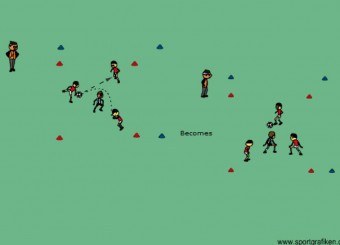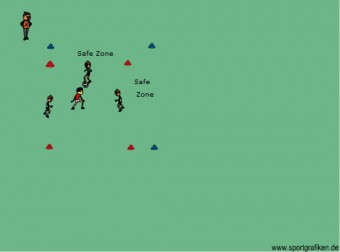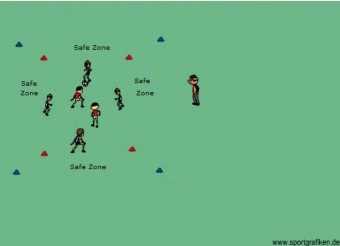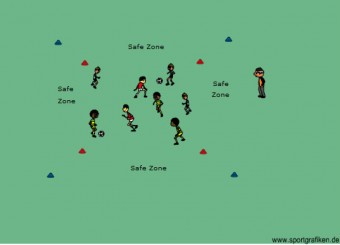The speed of the game at the highest levels continues to increase at a rapid pace. More passes are being attempted and completed at a higher percentage than ever before. In the 2009 Champions League final vs. Manchester United, the Barcelona triumvirate of Messi, Ineista, and Xavi attempted 206 passes and completed a remarkable 194 of them! In an English Premier League match 80 % of the passes are played with one or two touches with 78% of passes being delivered in distances of less than 25 yards.
What conclusions can we draw from these numbers as we prepare future players? Playing in tight spaces while under pressure is becoming the rule not an exception. The ability to combine with teammates is vital whether the ball is along the ground or in the air. Passes are being played with more weight to them making the technical ability to receive the ball tight to the body of greater importance. Defenses have become more organized and compact so that space to play in is becoming increasingly limited. The ability to make quick correct decisions, pass the ball with various surfaces of the body and with great deception is the way forward.
This past January I had the privilege to observe Dick Bate, English FA and UEFA Technical Staff, run a field session presenting ideas on how to train youth players in an age appropriate and fun environment to meet the future demands of the game.
Bate’s Three Tips to keep possession:
- Play Simple- Don’t complicate things.
- Play Early- one touch if you can, two touch if you have to, three touch if you must!
- Play Quick- Pace of the pass is important. Can you fire it to the receiver? The quicker it gets there the more time the receiver will have on the ball to make a decision.
3v1 Warm-up
 The Set-up: groups of 4, 1 ball between them in a grid 8×8 (10×10 for younger players). The blue outer discs will be used as the practice progresses, but aren’t needed for the warm-up.
The Set-up: groups of 4, 1 ball between them in a grid 8×8 (10×10 for younger players). The blue outer discs will be used as the practice progresses, but aren’t needed for the warm-up.
The Exercise: One player serves as a defender (should hold a pinnie), one player starts with the ball in their hands, the other two players move to get open. The player with the ball tosses to either of his two teammates who attempt to volley it or head it to the other player. You can volley directly back to the server if the other player is covered. The defender can only intercept the volley or header not the serve. If the defender wins the ball, he should drop the pinnie and become the server. The activity should be continuous.
Progress to: The game remains 3v1, but the ball is now on the floor. If the group of 3 can connect 5 passes without losing the ball, they should pick the ball up and try to connect 5 passes through the air.
Focus:
- Keeping possession through the air or along the ground
- Movement of the ball (provide good supporting angles)
- Passing with all surfaces
- Deception
1st Activity: 3v1 with Safe Zone
 The Set-up: groups of 4, 1 ball between them in a grid 8×8 (10×10 for younger players). The blue outer discs create a 2 yard “safe zone” on two sides of the grid for the attacking players.
The Set-up: groups of 4, 1 ball between them in a grid 8×8 (10×10 for younger players). The blue outer discs create a 2 yard “safe zone” on two sides of the grid for the attacking players.
The Exercise: 3v1. The group of 3 should attempt to move the ball at speed (one touch if you can, two touch if you have to, three touch if you must!) to wear the defender out. If the player on the ball is under extreme pressure, he should turn away from the defender and enter the “safe zone”. This mirrors the decision to shield the ball or play backwards in the game to relieve pressure.
There is always a path to keep possession! Don’t give the ball away.
Bate’s Four Routes to escape pressure:
- To the Right of the defender
- To the Left of the defender
- Through the defender (legs)
- Away from him (shield)
2nd Activity: 4v2 with safe zone
 The Set-up: groups of 6, 1 ball between them in a grid 12×12 (15×15 for younger players). The blue outer discs create a 2 yard “safe zone” on all four sides of the grid for the attacking players.
The Set-up: groups of 6, 1 ball between them in a grid 12×12 (15×15 for younger players). The blue outer discs create a 2 yard “safe zone” on all four sides of the grid for the attacking players.
The Exercise: 4v2. The group of 4 should attempt to move the ball at speed (one touch if you can, two touch if you have to, three touch if you must!) to wear the 2 defenders out. If the player on ball is under extreme pressure, he should turn away from the defender and enter the “safe zone”.
Note: When the player on the ball enters the safe zone, aof his/her teammates should widen out to the safe zones. The player on the ball must now pass a deep ball across the zone before the 4 re-enter the “live” area. This will train the players to play a deeper pass to change to the point of attack.
3rd Activity: Multiple 3v1’s in the same area
 The Set-up: two groups of 4, 1 ball for each group in a grid 12×12 (15×15 for younger players). The blue outer discs create a 2 yard “safe zone” on all four sides of the grid for the attacking players.
The Set-up: two groups of 4, 1 ball for each group in a grid 12×12 (15×15 for younger players). The blue outer discs create a 2 yard “safe zone” on all four sides of the grid for the attacking players.
The Exercise: Simultaneous 3v1’s. The groups of 3 should attempt to move the ball at speed (one touch if you can, two touch if you have too, three touch if you must!) to wear the defender out.
Note: The defenders only defend one ball. They aren’t working as a pair. If the player on the ball is under extreme pressure, he should turn away from the defender and enter the “safe zone”.
Make it a competition: Have the groups compete against one another. Play for 90 seconds and see which group can retain possession the best. Which group loses possession of the ball the fewest times?
Although the activity remains a 3v1, the increased congestion will place a greater demand on the players.
Focus:
- Keeping possession through the air or along the ground
- Movement of the ball (provide good supporting angles)
- Passing with all surfaces
- Deception
- Communication
- Playing with head up
Progress to Multiple 4v2’s
Conclusion: The modern game is becoming faster and faster which creates more technical and tactical challenges on our players. We, as coaches, need to recognize this trend and create a training environment that meets these demands through dynamic, challenging and fun activities that help our players meet the demands of the modern game.
The exercises listed above are just a small sample of how we can use dynamic, game like activities to engage our players. Our challenge is to revisit our approach to training on a daily basis is to make sure that we help our players meet the challenges the game presents on a daily basis. A question to ask yourself when preparing a session, does it happen in the game? If so, let’s create a training session that addresses the issue.
Feedback and comments are always welcome at bdonahue@lexingtonsoccer.org